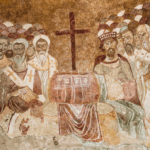Cathy Altmann is a poet, teacher and violinist from Melbourne, Australia. Her first collection, Circumnavigation (Poetica Christi Press, 2014), won the FAW Anne Elder Award and her second collection, things we know without naming (Poetica Christi Press) was published in December 2018. Her poetry has appeared in journals, anthologies, The Disappearing website and on Melbourne’s trains as part of the Moving Galleries project. She holds a Masters in Creative Writing from the University of Melbourne and currently teaches English and Latin.
TGCA: Last year you released your second book of poetry things we know without naming—a follow-up to your first anthology, Circumnavigation. How would you compare your experience of writing and compiling these two collections?
 Quite different, really. The first one came about over 9 years, and most of the poems were in response to my experience of breast cancer. After that was published, I wasn’t sure when or if I would manage another book, but after about three years I assembled all the poems I had written on scraps of paper, in journals or on my laptop and was delighted to realise there were enough for a book. I’d been more productive than I realised. But both books had a fairly long process—especially the first one!—of compiling and assembling the poems.
Quite different, really. The first one came about over 9 years, and most of the poems were in response to my experience of breast cancer. After that was published, I wasn’t sure when or if I would manage another book, but after about three years I assembled all the poems I had written on scraps of paper, in journals or on my laptop and was delighted to realise there were enough for a book. I’d been more productive than I realised. But both books had a fairly long process—especially the first one!—of compiling and assembling the poems.
In the first book I was greatly helped by Alex Skovron, an older poet, who kindly mentored me, even though the meetings were sometimes years apart. In the second book, I was able to use that experience and the structure he provided (the idea of different sections) to assemble the book. I also sent an early draft to Philip Salom, my first poetry teacher, who actually felt it wasn’t working as a collection very well. That was discouraging but helpful. I ended up getting rid of about half the poems and substituting others with stronger imagery—which took nearly a year. It’s a bit like assembling an orchestra. A whole lot of individual instruments, fine on their own, need to blend and balance into an ensemble. Quite tricky. And I haven’t mentioned the writing process, which was also different. In the first collection, poems came (often with tears) out of the process of breast cancer treatment and recovery. In the second, I allowed myself to be more unconscious, at times, and just see what came. That’s what seemed to work. Even though I was worried some poems might not make sense to people, and I’ve discussed this in the introduction, I hope that people can read their own meanings into them and that the things we know without naming—almost beyond words—are still palpable.
TGCA: Were there surprises for you as you assembled the collection?
I guess the delight of putting a collection together is the way poems speak to each other. You may not have noticed when writing them, but images of the moon, for example (which I seem to refer to a lot!) echo other images, and poems placed next to each other or in the same section can resonate. So the whole final section of the book has poems about travel, first to other countries and then across Australia, and although I had written these at different times, they worked well together.
TGCA: You write in your Introduction that some poems are harder to understand and that you have adopted a new kind of writing which allows words to come. Can you tell us how this new process is different from your old approach?
I think my old approach was more literal. I was more in control. I mean the images still came as a kind of gift, and unbidden. But more recently I have found that my best writing is when I take my foot off the brake (or my hands off the controls) and let words come. I was speaking to a friend at church who talked about how she paints with watercolours. She said that she goes into a sort of dreamy zone, and ‘lets the paint do the work’. Just as the paint falls on the page, it makes a shape which suggests a person or a tree to her, and that suggests the next shape. I loved this idea of ‘letting the paint do the work,’ and said, ‘That’s exactly what I’m doing – letting the words do the work. So that, as they come onto the page, they have a sound which suggests other sounds, or create an image for me which suggests the next image.’ Anyhow, it’s just surrendering control and trusting that things will come. I then go back and work out if anything has come which is worth saving, editing and so on.
TGCA: You say that the whole process is a ‘form of prayer.’ Later, in ‘Bread and Stone’ you talk about ‘reading poetry instead of praying,’ What part does writing poetry play in your life as a Christian?
Yes, it is really hard to describe, but often when I’m writing I’m in a zone which is prayerful. Part of me is asking God, or depending on God, or trying to tell the truth which might hurt, or receiving from God. That unconscious part of myself which delights to play and is free to explore, is freed by God. It may not be consciously prayerful, but the whole thing is a gift. The invitation to write I see as Christ’s invitation. And the desire to share with others is also from God. And certainly he has provided so much encouragement in my writing, from my publisher Poetica Christi Press, the responses of people who have read the poems, to the provision of mentors and good graphic designers like yourself and Cam Semmens.
The whole thing is a gift. The invitation to write I see as Christ’s invitation. And the desire to share with others is also from God. And certainly he has provided so much encouragement in my writing
Writing is a way in which I express what is truly myself and share that with others—and poetry is a way of sharing truths which are almost beyond words, things about grief and life and sex and death. So that communication with others through the vulnerability of sharing and through creativity is just how we are hard-wired as people created by a creative God.
 TGCA: Have you been writing poetry all your life?
TGCA: Have you been writing poetry all your life?
No. I’ve been reading poetry for a lot of my life, but not writing. I used to write poetry at school. I also wrote short stories. Then I lost confidence and decided I couldn’t write very well any more, or the gift had gone or something. Just my own perfectionism, I think. I remember struggling with writing being a valuable thing to do as a Christian, but one of my small group members who’s an architect reminded me that God is a creative God! My father was an English teacher, so he encouraged in me a love of poetry. When I taught violin at the same school as him, he would often leave a poem on his desk for me to find. Actually I then stopped reading poetry in my 20s as I found it all too obscure.
When I was in my 30s, I had to give up my teaching job and move to Bulleen, as John [Cathy’s husband] took up the position of minister there, and I had a six-month old. John spotted an ad for a creative writing course at Deakin in the paper and I enrolled part-time. In my first lesson with Philip Salom we had to write a haiku (3 lines). How could I do that?! I was just aware of all the great poets and felt I couldn’t measure up. It was largely due to Philip’s encouragement, then later the Christian poets in the Wordsmiths and people like Kathryn Hamann, that I continued writing. In God’s providence, I began writing poetry only a year or two before I got diagnosed with breast cancer (in 2005), so I had a medium for transforming what I was going through.
TGCA: What is it that you like best about writing poetry?
I love the unexpectedness of images—what words can do when placed next to each other. I love the sounds and pictures they form. I also love the way poetry can hint at or hold painful, complex emotions—things I can’t say in another form—partly because it is so condensed. I love the way I can turn experience into a work of art, or creativity, that speaks to other people. My friend on the phone last night said he had been rereading some of my poems from the first book and appreciating them. I find that just immensely encouraging.
TGCA:Have you found ways to help people appreciate poetry in your experience an English teacher?
People can definitely be helped to enjoy it. I love spending time with my English students doing close analysis of Wilfred Owen’s poems, for example. They come alive as we spend time reading them. I guess poetry is so concentrated that the main advice I would have is read it slowly. Absorb it. Don’t expect it to all ‘make sense’ but let the words and images suggest things to you. Just enjoy whatever comes to mind.
What else? I tell my students to look at the end closely. Often in the final lines a poem will move from being about the beach, say, to being about the afterlife—not sure if that’s a good example, but I had to study a poem recently with my Year 12s which was all about two wasps building a nest in the poet’s mailbox (‘The Wasps’ Nest’ by James Rosenberg). It was quite funny at times. But at the end, the poet says he won’t destroy the nest, because he too knows what it is like to live ‘In an alien and gigantic universe, a stranger/ Building fragile citadels of love/ On the edge of danger’. I love that image of ‘fragile citadels of love.’ And when we looked closer, we noticed that ‘fragile’ is the opposite of ‘citadel’, but we can understand that this is what love is. What any two people might create is a fragile citadel on the edge of danger.
TGCA: Are there better or worse ways of talking about poetry?
I guess I try not to get my students to reduce it to ‘a message’. It’s important to try to appreciate what the writer is suggesting. But there is also room for the images and feelings it evokes in us! One of my best experiences was a birthday afternoon tea when I thought I’d share with a few friends a poem or two I’d written recently. It was so lovely to hear the different things it meant to each of them. So I think being sincere, rather than being impressive is best. I have been very moved, too, by the poets who have launched my books and their ability to get inside the poems and my experience without knowing me well.
TGCA: What is your process when it comes to writing a poem? Do you set regular times to write? Do you carry a notebook about?
I have various notebooks around the house, and I will also write on scraps of paper if needed! All of this says to me that ‘it isn’t a big deal; just do it’. I might go to a café in the holidays and write something. If I write, it’s often at the end of a day, or when I’m relaxing after school. I feel something building up, or some grief, or some invitation, and sit in my study or on the couch. Then I just write and let the words do the work. Sometimes I have music on. As I write, I’m trying to listen, trying to let pictures come. Recently a friend at school told me a Les Murray quote: ‘you have to tell the absolute truth, so far as you can dredge that up.’ So I might try to do that! I come to write in response to God, really, and know that I might need to be prepared to go into some painful truth, about my daughter growing up, for example. At other times, it’s just recreation and fun. Start and see what happens.
Recently a friend at school told me a Les Murray quote: ‘you have to tell the absolute truth, so far as you can dredge that up.’ So I might try to do that! I come to write in response to God, really, and know that I might need to be prepared to go into some painful truth
TGCA: Are there times when you find it easier or harder for you to write?
I need to be alone, but that can be at a table in a café. It’s easier after reading other writers, so I might do that to begin. It’s easier if some experience has just made an impression on me, or I have been carrying around some image or event – though the words don’t always come. I find the holidays good for editing and putting together work. It’s harder if I’m in the midst of over-stretching myself with my teaching. But it’s a good mental break!
TGCA: Who are some of your favourite poets?
Louise Gluck, Seamus Heaney, Emily Dickinson (a discovery when I was a teenager), John Donne (likewise). Melbourne poets Jennifer Harrison, Peter Bakowski. I do enjoy the wit and brilliant writing of Alex Skovron. I enjoy working my way through the Australian Poetry Anthology, which comes out a few times a year, discovering new poets and admiring old favourites.
TGCA: One of the great things about your poetry is its sense of place. Are you conscious of ways that being Australian (or coming from Melbourne) makes you write differently?
I guess my poetry is full of things from the Australian landscape: gum trees; sometimes imagery from central Australia or places like Eucla; trams from Melbourne; my memories of growing up in Caulfield; Uni days around Carlton. I wrote a poem about driving home along the Eastern Freeway past all the sites of my growing up. I’ve written about coffee with a friend in a café. The stars … suburbia. At the same time, my father’s influence and my love of literature means there might be references to places and writers outside Australia. And my love of Latin means there might be Classical or mythical references … but I’m aware that these don’t belong to this landscape, too—we’re at the edge of that Western cultural heritage. Yet it’s part of my love and identity. And most of my poems start with the tree outside my window!
TGCA: Are there a couple of poems from the collection that you would like to share and talk about a little?
Maybe the last poem, since it’s about place and weaves in Classical references, too. I was introduced to the poetry of Catullus (1st cent. BC) by a wonderful Latin teacher at high school. She pointed out how his poem of joy at reaching his beloved island, Sirmio, had a sense of humour in the sound of all the plains he had to pass through to get there: ‘Thynia and Bithynia’—you can hear their boring flatness. The place that gives me similar joy is Shoreham, on the Mornington Peninsula, where we have holidays each summer. I feel an immense relief at reaching the house. I also had a powerful emotion as I came up out of the waves towards the beach, which became the end of the poem.
Thynia
(After Catullus)
Coming sodden through land-soaked,
crazy Thynia (past Bithynia),
and finally to where leaves flicker
like fish; the house is becalmed.
There are ferns here. Words
alight at the bird feeders
and flurry away, but sometimes I
can make out their white-lined
eyes and plush wings – look
them up in a book.
The pines sing. On hot days
they blow gusts of needle
salt and slow air
down my throat. I run
and dive under water, glassy
green. I somersault up, spouting
sound, catching small grains, grinning
at nothing. My lungs go like bellows.
When I come in from the sea,
it feels like the start
and end of every story.
Secondly, ‘Mother’. This poem has references to Arthur Boyd and Judith Wright (‘Woman to Child’) or Gwen Harwood (‘Mother Who Gave Me Life’), but is an attempt to express some of my grief at my mother’s Alzheimer’s. I forgot to mention that the whole book is dedicated to mothers and sisters, especially my mother and my sister, who experienced a rare kind of liver cancer and thankfully survived. So this collection is unified by those strands too. When I visited my mother when she was first in high care, she was sometimes distressed and anxious for no reason, looking up at me in tears. This is the same silver barb I see in myself.
Mother
In the new moon
by the pool
I wait for mother –
for the first blood, bone,
womb of that woman
who birthed me
on a dark night, in
sweat and by a billabong,
some slick oil
painting by Boyd, half
wild. But when she
comes she is nervous,
twisting her hair in
her fingers on car trips,
looking up from her
colouring in and asking
what she should do,
both of us hooked
with the same silver
barb, impossible to
dislodge, close as sinew.















